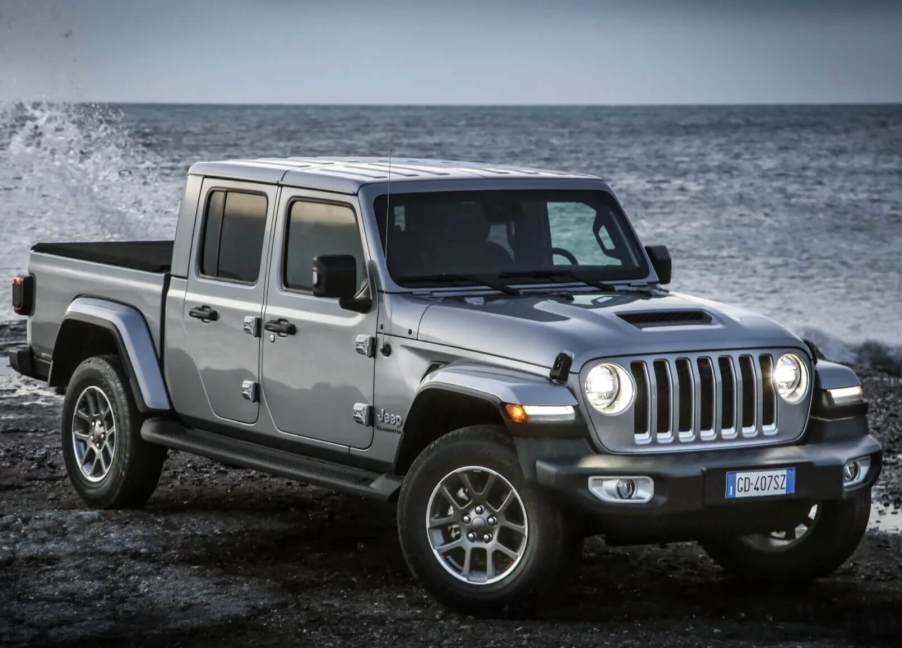
The Jeep Gladiator EcoDiesel Is an Instant Classic Truck
Building an all-new Jeep truck—the Gladiator—was a bold move on the automaker’s part. Offering it with the turbocharged 3.0-liter “EcoDiesel” V6 developed for the Ram 1500 was even bolder. The resulting configuration is the only diesel mid-size pickup truck and a very unique Jeep vehicle. I would even call the EcoDiesel an instant classic, but that’s not necessarily a good thing.
The Jeep Gladiator EcoDiesel truck is already outdated

When Car and Driver reviewed the diesel 2023 Jeep Gladiator, the publication did not mince words. It admitted that the “diesel is not as quick as its gas-powered counterpart.” Yet the engine is “louder” than the gasoline version. In addition, this engine “weighs an extra 500 pounds, and its maximum tow rating is lower.” Even the EcoDiesel Gladiator’s payload capacity is lower than the gasoline version’s.
The EcoBoost requires diesel exhaust fluid and a more expensive fuel than the petroleum engine. To top it all off, this “upgrade” costs $4,650.
Every Gladiator has a relatively small cab for a pickup truck. Its squared-off design causes ample wind noise, especially in a soft top configuration. Its solid front axle layout—a technological solution that’s fallen out of favor even with many full-size trucks—can make it a handful at high speeds. And its body-on-frame construction looks increasingly outdated with every sturdier generation of unibody crossovers.
You could say the Jeep Gladiator, especially the EcoDiesel variant, was outdated even before it was released.
The Jeep Gladiator EcoDiesel truck will echo in eternity

We’re idling at a crossroads. Motoring enthusiasts and our entire society, have some important decisions to make about the future of transportation. Not the least of these is what will happen to classic cars after the twin revolutions of electrification and automation have run their course.
Considering that modern hobbyists keep horses, wooden boats, and even steam locomotives, I expect future generations will be driven to restore internal combustion engines. But doing so will test their resolve and ingenuity.
What vehicles will future generations seek out and restore? What will spark joy? I believe multiple current Jeeps, especially the Gladiator, will be trendy classics in the coming decades.
If you already have an efficient and reliable automated EV, what would you choose for a weekend toy? Something analog, visceral, messy, and fun. Something you can get dirty off-road or drop the top and take for a cruise. The final few model years of internal combustion cars—in relatively good shape and outfitted with Apple CarPlay and driver aids—will be especially sought after.
One major hurdle will be sourcing fuel. But I expect that diesel truck stops will remain a fact of life for decades, as the current semi fleet continues running. It may also take a few generations of EVs to get long-range electric trucking right. Because diesel fuel will be readily available, diesel classics will be a hot commodity. The Jeep Gladiator EcoDiesel is the final timeless square-body pickup truck, and as such, it will echo into eternity.
What will happen to classic Jeeps?

Perhaps a cleaner, safer, and cheaper fleet of automated EVs will make for a much better future. But there have always been some enthusiasts who insist on doing things themselves, even if that means getting their hands dirty with older technologies. Restoring and maintaining classic vehicles such as Jeeps is a great way to build important life skills. And you certainly don’t have to commute in your classic to gain the benefits of owning it.
Moreover, a source in the EPA revealed that while the agency is targeting a commuter fleet running off clean energy, it has no interest in coming after classic hobby cars. This is because their contribution to greenhouse gases is negligible. So while the Jeep Gladiator may have been born already a relic, I doubt this instant classic is going anywhere.
Next, read more reasons the Wrangler is outdated, and Jeep fans don’t care.



